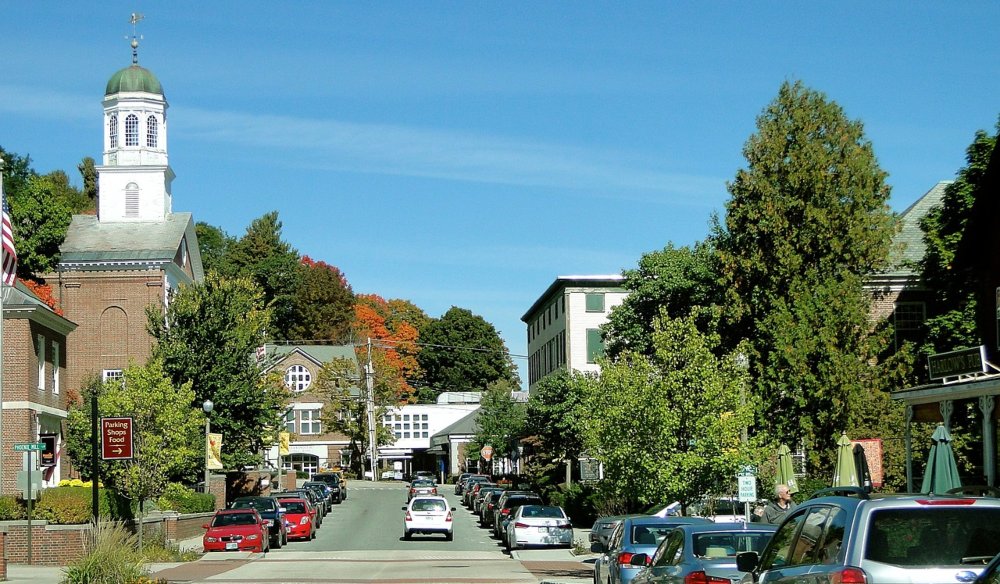One of the things that is striking, to this westerner, on visiting New England is the visible prominence of the Congregational Church. One in every town and village, or so it seems. Most located on a central town green. This one is in Canaan, Connecticut in the western part of the state. We passed it on the way north to the Berkshires in western Mass.
And even though most did join the United Church of Christ at the time of the merger in 1959, they opted as a colleague put it, “to keep their maiden name.” So “First Church Congregational” or “First Congregational Church.” Sometimes “Church of Christ Congregational” — these are all over the place — not United Church of Christ. The latter may appear in the fine print — or not.

Almost all are plain, white structures. Either “simple” or “austere,” depending on how you feel about this sort of thing. The traditional New England “meeting house” style. A wood building perched on foundations of grey, New England fieldstone. Sanctuary windows of clear glass. Congregationalists disdained the decorative, e.g. stained glass windows, as “pope-ish,” i.e. Catholic.
The sole element of a decorative nature was a cloth beneath the Bible on the pulpit. Makes me think of novelist John Updike who somewhere wrote that he preferred his religion from the “old stone jars,” and not gussied up or modernized.
The “meeting house” was where you went to meet and be met by God, or as Updike also said, a place to “dream about God.” Secondarily these were the sites of the New England “town meeting” and, as such, a birthplaces of democracy.
On this trip, I’ve mostly been with clergy friends who have served Congregational churches in New England their whole careers. They know the people, the churches, the colleges and seminaries of New England Congregationalism. It’s what anthropologists call a “thick culture,” and unlike anything we have in the west. It’s not that all this is invulnerable to the secularizing trends and church decline evident in other parts of the U.S. Just that the cultural imprint of my tribe is deeper here. Yay team! That said, such an establishment probably would have driven me crazy if I’d been a minister here.
And you don’t see the mega-churches, or wannabe megas, here that are so common in the west. “Revive” in the strip mall or “New Life” by the freeway.
Also different, at least compared with Seattle and the I-5 corridor, is the amount of open space here in New England. Kind of counter-intuitive. You think of the west in terms of wide, open spaces, which there are on the eastern side of the Cascades, or on either flank of the Rockies. But the New England countryside seems much less dense, sprawling lawns, open land and wooded rolling hills structure-free.

Autumn, even if this isn’t the “best” year for leaf-peepers, is still quite gorgeous. Lots of color on the drive with my friend Mike Bennett from New Hampshire south to New Haven. Even more on the way back north with another pal, Rick Floyd, as we headed to the Berkshires of western Massachusetts. At right, from a hike at a nearby lake here in Pittsfield, Mass.
And more thick culture in other ways. Herman Melville, Nathaniel Hawthorne, Edith Wharton are famous writers who lived here in the Berkshires, as did Norman Rockwell, the artist of archetypal scenes of an earlier (white) America, which I’m sure some regard as sentimental. Rick did say that Rockwell had done paintings during and of the Civil Rights Movement era. But the Saturday Evening Post, where Rockwell’s work often appeared, had declined to publish them at the time.
And stuff is old. In Goshen, Connecticut we all stayed in a farmhouse, now B and B, that dated to 1789. And those lovely old, no mortar, rock walls all over the place.
All in all, a reminder that the U.S. is a big country with lots of regions and regional variation. Maybe its no wonder that we seem often to be pulling apart at the seams?
Discover more from Post Alley
Subscribe to get the latest posts sent to your email.

A lovely piece of writing! I miss some of the big old brick churches that anchored the apartment-filled neighborhoods I lived in during my twenties, in the U. District, and elsewhere. Too many have been demolished, along with the affordable and funky 30s apartments with names like The Louisa. I seldom went in the churches, but they seemed reassuring and benevolent. I liked to imagine all of the Sunday schools, weddings, even funerals, and pot lucks taking place. And yes, I agree completely about the myth of green Seattle. Look closely — it is going away.
Those white-steepled churches are really battle monuments, as New England in the 19th century turned into a battleground between Unitarians and Congregationalists and some others. The other thing that happened was an exodus of New Englanders to places west. A good book to read is “The Transcendalists and Their World,” by Robert Gross, a close look at Concord, Mass, which was split apart by dis-concord.
I have a friend who is just moving to the “Trinitarian Congregational Church” in Concord, actually the daughter of a friend. There is a nearby Unitarian Church also in Concord. The upside of having two so close is that often in UCC churches you have a lot of Unitarians or wannabe UU’s. So in the once disputed turf of Concord, they can go to the UU church and Trinitarians can go to what is known as ”
Tri-Con.”